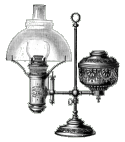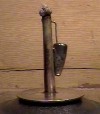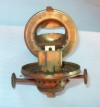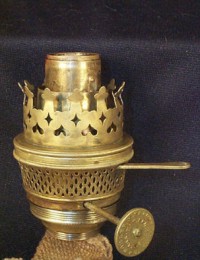 Kohler's Argand Burner with Extinguisher
Kohler's Argand Burner with Extinguisher
Using a Flat Wick Formed Round
[Mouse-over to operate the snuffer!]
|
The invention of the lamp or burner extinguisher predates the advent of the kerosene burner. In fact, the first patents for extinguishers were for camphene lamps. The volatile nature of camphene and other burning fluids sparked (pun intended) the minds of countless early inventors. One of the earliest patents dates to 1850. In the left margin is an example of an early camphene burner extinguisher by J.H. Noyes. Noyes attached his cap on a thin metal wire rather than the fine chain often seen on fluid burners. Between 1850 and 1900 there are well over three hundred patents for extinguishers and improvements.
Extinguishers generally fall into two broad categories: those intended as a convenience to the user and those designed to improve the safety of the lighting device. Most of the former are manually operated by the user, which is to say that the person must depress a lever or turn a thumbwheel to activate the snuffer. Many of the extinguishers were designed as safety devices to operate automatically to help reduce the risk of fire associated with these lighting devices. There are even patents for automatic extinguishers that activate when the fuel in the fount runs low. One such patent was that of Thomas Langston of Meriden, Connecticut - patent number 615,666 granted on December 6, 1898 and assigned to
Edward Miller & Company. Some of the early extinguisher patents for burning fluid were designed to prevent the user from removing the burner for filling while it was lit. Many of the safety devices operated by gravity if a lamp were accidentally knocked over or dropped. To read more about lamp-related accidents,
click here.
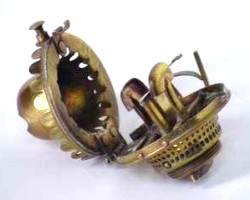 William A. Richardson & Henry D. Ward's Burner
William A. Richardson & Henry D. Ward's Burner
Patent Number 53,679 - Dated April 3, 1866 |
The designs of extinguishers vary greatly. The general principle is to enclose the flame or burner tube, thus robbing the flame of oxygen, and putting it out. Auxiliary tubes or mechanisms slightly larger than the wick tube are often employed. These can be raised by levers or gear-driven with another thumb wheel. The levers can be simple or compound systems. Many of the mechanisms are weighted to allow them to return to the "neutral" position. These weights may be internal to the burner (like the Lambertson, below), or extend below the burner base as in this image of a
Wilmot Burner. Others employ elements that cover or enclose the top of the wick tube - wings, clam shells, etc. - or cover the blaze hole in the deflector.
I often wonder how effective some of these devices were if the burners were not routinely cleaned and maintained. Kerosene and oil deposits, baked on the wick tube and encrusted with fine dust particles and lint, can make these snuffers difficult, if not impossible, to operate. While this would not be more than an inconvenience to the user of a manual snuffer, it could present a serious safety risk on the burners and lamps equipped with automatic extinguishers.
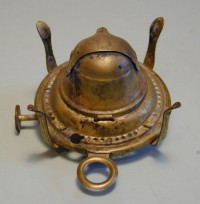 Byron H. Robb's Extinguisher Burner
Byron H. Robb's Extinguisher Burner
Patent Number 187,910 - Feb. 27, 1877
By The Benedict and Burnham Mfg. Co. |
The argand burner depicted above was patented by Charles Henry Kohler on April 12, 1881. This was patent number 239,964, an extinguisher for a tubular lamp burner. Unfortunately, this example is missing parts. This was an automatic safety burner operated by a weighted ball and chain (like the Robb's burner, right) that activated a brass cylinder that rode up the burner tube to snuff out the flame. Intact examples of these burners are hard to find - the more parts a burner had, the easier it was to break or misplace something over the years.
The burner (above right) is an automatic safety burner. This burner was invented by Byron H. Robb and was patented on February 27, 1877 as an improvement in lamp extinguishers. This burner was manufactured by the
Benedict and Burnham Manufacturing Company. Robb's design is a rotating cover that is activated by a weighted ball and chain (missing on this example) that rests on the hoop protruding from the side. The chain would have been attached to the snuffer and fed through the small hole in the burner body. If tipped, the ball would fall off its cradle, the weight of which would have moved the cover over the blaze hole, thereby putting out the flame.
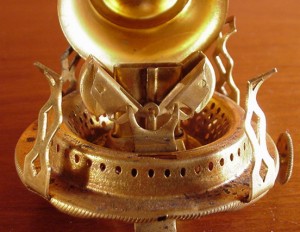 The SURPRISE Burner - Patented June 2, 1874
The SURPRISE Burner - Patented June 2, 1874
Manufactured by Wallace & Sons, Ansonia, Connecticut
|
The SURPRISE burner, shown left, is a number one size manufactured by
Wallace and Sons of Ansonia, Connecticut. This extinguisher mechanism is lever operated causing to clam shells to close around the wick tube, thereby smothering out the flame. Each of the clam shells is dated June 2, 1874. There were two extinguisher patents granted that day, but neither clearly depicts the SURPRISE, or this exact style of extinguisher. One is Frank Rhind's patent number 151,512; the other is Michael Wagner's patent number 151,524. Another Wallace & Son's burner with a clam shell extinguisher is
The Sun Hinge. Rather than the halves closing from the ends of the wick tube, these are elongated clam shells closing from the front and the back of the wick tube.
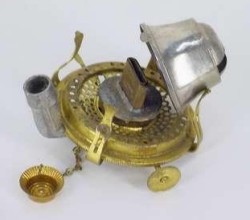 The Lambertson Burner - fill cap removed,
The Lambertson Burner - fill cap removed,
deflector open, showing weighted extinguisher
|
The Lambertson burner is a prong-style burner designed to accommodate a slip chimney. It was made in both the number one and number two sizes, taking a chimney with a fitter diameter of 2-1/2 and three inches, respectively. It also was available in both sizes with or without the side filler tube - all examples have the lever extinguisher. There was also an aftermarket lantern burner available, again in two sizes. All of the burners are designed with a brass body and heavily embossed prongs and a nickel-plated burner cone. The weighted extinguisher consists of a brass tube, slightly larger that the burner's wick tube, and a cast lead weight around the base. The tube is often marked NEWARK, N.J. along the top edge. The lead weight is marked as well - sometimes with a patent date and Phoenix Mfg. Co. The thumbwheels are marked: PHOENIX MFG. CO / PAT. OCT. 18/87. The filler tubes have an embossed decoration along their underside and a crimped-edge cap attached by a small brass chain. Follow this link to read more about the
Lambertson Burner.
Rhind's Patent Safety Lamp --
 Rhind's Patent Kerosene Safety Lamp has been placed upon the market, and the public is invited to test it. Its qualities are: First, it extinguishes itself when overturned; second, it extinguishes itself when dropped from the hand; it cannot be filled when lighted, and can be carried about at pleasure. It is so constructed that blowing down the chimney or turning down the wick to extinguish the light is unnecessary. The New York Board of Underwriters have endorsed and recommended its use. Sample price, $1.25, sent free upon receipt of P.O. order. Merchants supplied at reasonable prices.
Rhind's Patent Kerosene Safety Lamp has been placed upon the market, and the public is invited to test it. Its qualities are: First, it extinguishes itself when overturned; second, it extinguishes itself when dropped from the hand; it cannot be filled when lighted, and can be carried about at pleasure. It is so constructed that blowing down the chimney or turning down the wick to extinguish the light is unnecessary. The New York Board of Underwriters have endorsed and recommended its use. Sample price, $1.25, sent free upon receipt of P.O. order. Merchants supplied at reasonable prices.
--from the Official Catalog of the 1876 International Exhibition
|
|
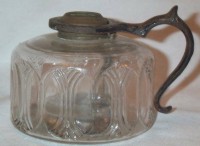 Frank Rhind Patented Safety Lamp
Frank Rhind Patented Safety Lamp
|
Many lamps were designed to prevent accidents that required special extinguisher burners. These lamps were made in all manners of kerosene lamps - glass and composite lamps; finger, hand and table lamps. Frank Rhind of Brooklyn, New York, a prolific inventor in his own right, held a number of patents for safety devices. Between September 9, 1873 and May 16, 1893, Rhind held at least nine patents for extinguishers: 142,730; 151,512; 197,174; 209,077; 209,078; 211,931; 390,254; 440,748; and 497,605. Many of Rhind's lamps, like the one pictured, had a ring around the collar that engaged the extinguisher mechanism. The ring was connected by a steel rod through a glass tube in the fount, to a weighted base. If knocked over or dropped, the unit was expected to extinguish the flame.

| A small selection of over 300 extinguisher patents, 1850-1900 |
| RE7256 |
RE8309 |
12394 |
46819 |
56770 |
59607 |
64671 |
71112 |
| 75317 |
86084 |
97271 |
97453 |
102926 |
118280 |
138812 |
142730 |
| 147807 |
151512 |
157503 |
160988 |
163556 |
172035 |
177947 |
185225 |
| 187910 |
198139 |
201411 |
209955 |
210878 |
217816 |
240407 |
257838 |
| 291995 |
317203 |
322599 |
add'l patents will be added as time permits |
| D = Design Patent, RE = Reissue of an earlier Patent |
To view any of the above patents, enter the number in the box below and select Query USPTO Database. This will take you to the specific patent images on the U.S. Patent & Trademark Office Database. Learn more about the USPTO here.
 Lamp Burner Extinguisher Patents
Lamp Burner Extinguisher Patents